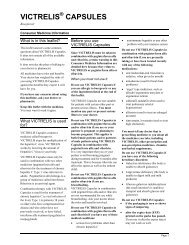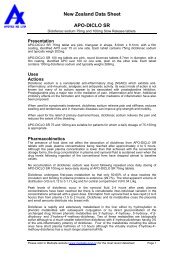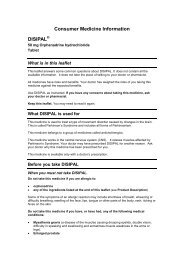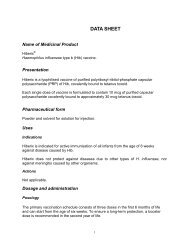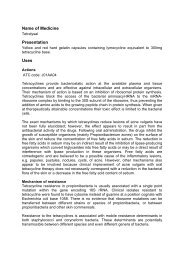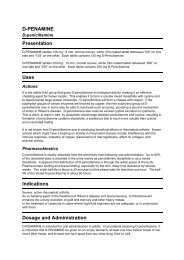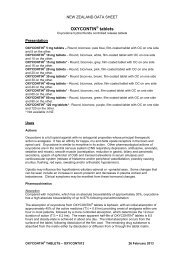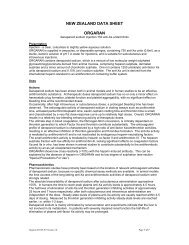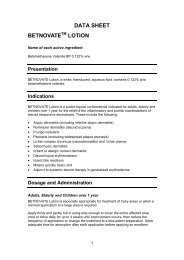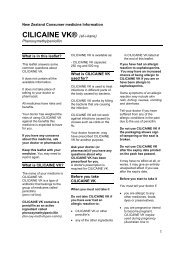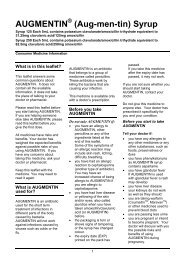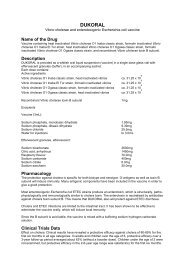SINGULAIR® - Medsafe
SINGULAIR® - Medsafe
SINGULAIR® - Medsafe
Create successful ePaper yourself
Turn your PDF publications into a flip-book with our unique Google optimized e-Paper software.
Name of Medicine<br />
SINGULAIR ®<br />
montelukast sodium<br />
10 mg tablet<br />
5 mg chewable tablet<br />
4 mg chewable tablet<br />
Presentation<br />
10 mg tablet: A beige rounded square film-coated tablet engraved with SINGULAIR on<br />
one side and MSD117 on the other, containing 10.4 mg of montelukast sodium which is<br />
the molar equivalent of 10.0 mg of free acid. Dimensions: 7.87 x 7.87 mm.<br />
5 mg chewable tablet: A pink round biconvex chewable tablet with a cherry flavour<br />
engraved SINGULAIR on one side and MSD275 on the other, containing 5.2 mg of<br />
montelukast sodium which is the molar equivalent of 5.0 mg of free acid. Dimensions:<br />
9.525 mm diameter.<br />
4 mg chewable tablet: A pink round biconvex tablet with a cherry flavour engraved<br />
SINGULAIR on one side and MSD 711 on the other, containing 4.2 mg montelukast<br />
sodium which is the molar equivalent of 4.0 mg of free acid.<br />
Therapeutic Class<br />
SINGULAIR (montelukast sodium) is a selective and orally active leukotriene receptor<br />
antagonist that specifically inhibits cysteinyl leukotriene CysLT1 receptor.<br />
Indications<br />
SINGULAIR is indicated in adult and paediatric patients 2 years of age and older for the<br />
prophylaxis and chronic treatment of asthma, including the prevention of day- and nighttime<br />
symptoms and the prevention of exercise-induced bronchospasm.<br />
SINGULAIR is indicated in adults and paediatric patients 2 years of age and older for the<br />
relief of daytime and nighttime symptoms of seasonal allergic rhinitis and perennial allergic<br />
rhinitis.<br />
Dosage and Administration<br />
SINGULAIR should be taken once daily. For asthma, the dose should be taken in the<br />
evening. For allergic rhinitis, the time of administration may be individualised to suit<br />
patient needs.<br />
Patients with both asthma and allergic rhinitis should take only one tablet daily in the<br />
evening.<br />
Adults 15 Years of Age and Older with Asthma and/or Allergic Rhinitis<br />
The dosage for adults 15 years of age and older is one 10 mg tablet daily.<br />
Paediatric Patients 6 to 14 Years of Age with Asthma and/or Allergic Rhinitis<br />
The dosage for paediatric patients 6 to 14 years of age is one 5 mg chewable tablet daily.<br />
Paediatric Patients 2 to 5 Years of Age with Asthma and/or Allergic Rhinitis<br />
SINGULAIR Tablets Datasheet A20130212v3 Page 1 of 10
The dosage for paediatric patients 2 to 5 years of age is one 4 mg chewable tablet daily.<br />
General Recommendations<br />
The therapeutic effect of SINGULAIR on parameters of asthma control occurs within one<br />
day. SINGULAIR may be taken with or without food. Patients should be advised to<br />
continue taking SINGULAIR while their asthma is controlled, as well as during periods of<br />
worsening asthma.<br />
No dosage adjustment is necessary for paediatric patients, for the elderly, for patients with<br />
renal insufficiency, or mild-to-moderate hepatic impairment, or for patients of either<br />
gender.<br />
Therapy with SINGULAIR in Relation to Other Treatments for Asthma<br />
SINGULAIR can be added to a patient’s existing treatment regimen.<br />
Reduction in Concomitant Therapy<br />
Bronchodilator Treatments: SINGULAIR can be added to the treatment regimen of<br />
patients who are not adequately controlled on bronchodilator alone. When a clinical<br />
response is evident (usually after the first dose), the patient’s bronchodilator therapy can<br />
be reduced as tolerated.<br />
Inhaled Corticosteroids: Treatment with SINGULAIR provides additional clinical benefit to<br />
patients treated with inhaled corticosteroids. A reduction in the corticosteroid dose can be<br />
made as tolerated. The dose should be reduced gradually with medical supervision. In<br />
some patients, the dose of inhaled corticosteroids can be tapered off completely.<br />
SINGULAIR should not be abruptly substituted for inhaled corticosteroids.<br />
Oral Corticosteroids: Limited data suggest that SINGULAIR may provide additional<br />
clinical benefit in patients with oral corticosteroids.<br />
Contraindications<br />
Hypersensitivity to any component of this product.<br />
Warnings and Precautions<br />
The efficacy of oral SINGULAIR for the treatment of acute asthma attacks has not been<br />
established. Therefore, oral SINGULAIR should not be used to treat acute asthma<br />
attacks. Patients should be advised to have appropriate rescue medication available.<br />
While the dose of concomitant inhaled corticosteroid may be reduced gradually under<br />
medical supervision, SINGULAIR should not be abruptly substituted for inhaled or oral<br />
corticosteroids.<br />
Neuropsychiatric events have been reported in patients taking SINGULAIR (see Adverse<br />
Effects). Since other factors may have contributed to these events, it is not known if they<br />
are related to SINGULAIR. Physicians should discuss these adverse experiences with<br />
their patients and/or caregivers. Patients and/or caregivers should be instructed to notify<br />
their physician if these changes occur.<br />
The reduction in systemic corticosteroid dose in patients receiving anti-asthma agents<br />
including leukotriene receptor antagonists has been followed in rare cases by the<br />
occurrence of one or more of the following: eosinophilia, vasculitic rash, worsening<br />
pulmonary symptoms, cardiac complications, and/or neuropathy sometimes diagnosed as<br />
SINGULAIR Tablets Datasheet A20130212v3 Page 2 of 10
Churg-Strauss syndrome, a systemic eosinophilic vasculitis. Although a causal<br />
relationship with leukotriene receptor antagonism has not been established, caution and<br />
appropriate clinical monitoring are recommended when systemic corticosteroid reduction<br />
considered in patients receiving SINGULAIR.<br />
Pregnancy<br />
SINGULAIR has not been studied in pregnant women. SINGULAIR should be used<br />
during pregnancy only if clearly needed.<br />
During worldwide marketing experience, congenital limb defects have been rarely reported<br />
in the offspring of women being treated with SINGULAIR during pregnancy. Most of these<br />
women were also taking other asthma medications during their pregnancy. A causal<br />
relationship between these events and SINGULAIR has not been established.<br />
Nursing Mothers<br />
It is not known if SINGULAIR is excreted in human milk. Because many medicines are<br />
excreted in human milk, caution should be exercised when SINGULAIR is given to a<br />
nursing mother.<br />
Paediatric Use<br />
SINGULAIR has been studied in paediatric patients 2 to 14 years of age (see Dosage and<br />
Administration). Safety and effectiveness in paediatric patients younger than 2 years of<br />
age have not been studied. Studies have shown that SINGULAIR does not affect the<br />
growth rate of paediatric patients.<br />
Use in the Elderly<br />
In clinical studies, there were no age-related differences in the efficacy or safety profiles of<br />
SINGULAIR.<br />
Renal/Hepatic Impairment<br />
No dosage adjustment is required for patients with renal insufficiency or mild to moderate<br />
hepatic impairment. (See Pharmacokinetics; Hepatic Insufficiency & Renal Insufficiency.)<br />
Carcinogenicity and Mutagenicity<br />
There were no significant results seen with montelukast sodium in carcinogenicity or<br />
mutagenicity studies.<br />
Reproduction<br />
In pre-clinical studies, there were no significant results in reproduction studies conducted<br />
with montelukast sodium.<br />
Development<br />
In developmental toxicity studies, there were no treatment related adverse effects at doses<br />
up to 400 mg/kg/day in rats and up to 100 mg/kg/day in rabbits. Foetal exposure of<br />
montelukast sodium in rats and rabbits does occur and significant concentrations of<br />
medicine were observed in milk of lactating rats.<br />
Effect on and Ability to Drive and use Machines<br />
There is no evidence that SINGULAIR affects the ability to drive and use machines.<br />
SINGULAIR Tablets Datasheet A20130212v3 Page 3 of 10
Adverse Effects<br />
SINGULAIR has been generally well tolerated. Adverse effects, which usually were mild,<br />
generally did not require discontinuation of therapy. The overall incidence of adverse<br />
effects (including laboratory adverse effects) reported with SINGULAIR was comparable to<br />
placebo.<br />
Adults 15 Years of Age and Older with Asthma<br />
SINGULAIR has been evaluated in approximately 2600 adult patients 15 years of age and<br />
older in clinical studies. In two similarly designed, 12-week placebo-controlled clinical<br />
studies, the only adverse experiences reported as medicine-related in ≥1% of patients<br />
treated with SINGULAIR and at a greater incidence than in patients treated with placebo<br />
were abdominal pain and headache. The incidences of these events were not<br />
significantly different in the two treatment groups.<br />
Cumulatively, 544 patients were treated with SINGULAIR for at least 6 months, 253 for<br />
one year and 21 for 2 years in clinical studies. With prolonged treatment, the adverse<br />
experience profile did not change.<br />
Paediatric Patients 6 to 14 Years of Age with Asthma<br />
SINGULAIR has been evaluated in approximately 475 paediatric patients 6 to 14 years of<br />
age. The safety profile in paediatric patients is generally similar to the adult safety profile<br />
and to placebo.<br />
In an 8-week, placebo-controlled clinical study, the only adverse experience reported as<br />
medicine-related in >1% of patients treated with SINGULAIR and at a greater incidence<br />
than in patients treated with placebo was headache. The incidence of headache was not<br />
significantly different in the two treatment groups.<br />
In studies evaluating the growth rate, the safety profile in these paediatric patients was<br />
consistent with the safety profile previously described for SINGULAIR.<br />
Cumulatively, 263 paediatric patients 6 to 14 years of age were treated with SINGULAIR<br />
for at least 3 months and 164 for 6 months or longer. With prolonged treatment, the<br />
adverse experience profile did not change.<br />
Paediatric Patients 2 to 5 Years of Age with Asthma<br />
SINGULAIR has been evaluated in 573 paediatric patients 2 to 5 years of age. In a 12week,<br />
placebo-controlled clinical study, the only adverse experience reported as<br />
medicine-related in >1% of patients treated with SINGULAIR and at a greater incidence<br />
than in patients treated with placebo was thirst. The incidence of thirst was not<br />
significantly different in the two treatment groups.<br />
Cumulatively, 426 paediatric patients 2 to 5 years of age were treated with SINGULAIR for<br />
at least 3 months, 230 for 6 months or longer, and 63 patients for 12 months or longer.<br />
With prolonged treatment, the adverse experience profile did not change.<br />
Adults 15 Years of Age and Older with Seasonal Allergic Rhinitis<br />
SINGULAIR has been evaluated in 2199 adult patients 15 years of age and older for the<br />
treatment of seasonal allergic rhinitis in clinical studies. SINGULAIR administered once<br />
daily in the morning or in the evening was generally well tolerated with a safety profile<br />
similar to that of placebo. In placebo-controlled clinical studies, no adverse experiences<br />
reported as drug related in ≥1% of patients treated with SINGULAIR and at a greater<br />
incidence than in patients treated with placebo were observed. In a 4-week, placebo-<br />
SINGULAIR Tablets Datasheet A20130212v3 Page 4 of 10
controlled clinical study, the safety profile was consistent with that observed in 2-week<br />
studies. The incidence of somnolence was similar to that of placebo in all studies.<br />
Paediatric Patients 2 to 14 Years of Age with Seasonal Allergic Rhinitis<br />
SINGULAIR has been evaluated in 280 paediatric patients 2 to 14 years of age for the<br />
treatment of seasonal allergic rhinitis in a 2-week, placebo-controlled, clinical study.<br />
SINGULAIR administered once daily in the evening was generally well tolerated with a<br />
safety profile similar to that of placebo. In this study, no adverse experiences reported as<br />
drug related in ≥1% of patients treated with SINGULAIR and at a greater incidence than in<br />
patients treated with placebo were observed.<br />
Adults 15 Years of Age and Older with Perennial Allergic Rhinitis<br />
SINGULAIR has been evaluated in 3235 adult and adolescent patients 15 years of age<br />
and older with perennial allergic rhinitis (defined as a history of symptoms for at least two<br />
years and positive skin tests for at least two perennial allergens) in two, 6 week, placebocontrolled,<br />
clinical studies. SINGULAIR administered once daily was generally well<br />
tolerated, with a safety profile consistent with that observed in patients with seasonal<br />
allergic rhinitis and similar to that of placebo. In these two studies, no adverse<br />
experiences reported as drug related in ≥1% of patients treated with SINGULAIR and at a<br />
greater incidence than in patients treated with placebo were observed. The incidence of<br />
somnolence was similar to that of placebo.<br />
Pooled Analyses of Clinical Trials Experience<br />
A pooled analysis of 41 placebo-controlled clinical studies (35 studies in patients 15 years<br />
of age and older; 6 studies in paediatric patients 6 to 14 years of age) was performed<br />
using a validated assessment method of suicidality. Among the 9929 patients who<br />
received SINGULAIR and 7780 patients who received placebo in these studies, there was<br />
one patient with suicidal ideation in the group taking SINGULAIR. There were no<br />
completed suicides, suicide attempts or preparatory acts toward suicidal behaviour in<br />
either treatment group.<br />
A separate pooled analysis of 46 placebo-controlled clinical studies (35 studies in patients<br />
15 years of age and older; 11 studies in paediatric patients 3 months to 14 years of age)<br />
assessing behaviour-related adverse experiences (BRAEs) was performed. Among the<br />
11,673 patients who received SINGULAIR and 8827 patients who received placebo in<br />
these studies, the frequency of patients with at least one BRAE was 2.73% in patients who<br />
received SINGULAIR and 2.27% in patients who received placebo; the odds ratio was<br />
1.12 (95% CI [0.93; 1.36]).<br />
The clinical trials included in these pooled analyses were not designed specifically to<br />
examine suicidality or BRAEs.<br />
Post-Marketing Experience<br />
The following adverse reactions have been reported in post-marketing use:<br />
Infections and infestations: upper respiratory infection<br />
Blood and lymphatic system disorders: increased bleeding tendency<br />
Immune system disorders: hypersensitivity reactions including anaphylaxis, very rarely<br />
hepatic eosinophilic infiltration<br />
Psychiatric disorders: agitation including aggressive behaviour or hostility, anxiousness,<br />
depression, disorientation, disturbance in attention, dream abnormalities, hallucinations,<br />
SINGULAIR Tablets Datasheet A20130212v3 Page 5 of 10
insomnia, memory impairment, psychomotor hyperactivity (including irritability,<br />
restlessness, and tremor), somnambulism, suicidal thinking and behaviour (suicidality)<br />
Nervous system disorders: dizziness, drowsiness, paraesthesia/hypoesthesia, very rarely<br />
seizure<br />
Cardiac disorders: palpitations<br />
Respiratory, thoracic and mediastinal disorders: epistaxis<br />
Gastrointestinal disorders: diarrhoea, dyspepsia, nausea, vomiting<br />
Hepatobiliary disorders: increased ALT and AST, very rarely hepatitis (including<br />
cholestatic, hepatocellular, and mixed-pattern liver injury)<br />
Skin and subcutaneous tissue disorders: angioedema, bruising, erythema multiforme,<br />
erythema nodosum, pruritus, rash, urticaria<br />
Musculoskeletal and connective tissue disorders: arthralgia, myalgia including muscle<br />
cramps<br />
General disorders and administration site conditions: asthenia/fatigue, oedema, pyrexia<br />
Interactions<br />
SINGULAIR may be administered with other therapies routinely used in the prophylaxis<br />
and chronic treatment of asthma, and in the treatment of allergic rhinitis. In medicineinteractions<br />
studies, the recommended clinical dose of montelukast did not have clinically<br />
important effects on the pharmacokinetics of the following medicines: theophylline,<br />
prednisone, prednisolone, oral contraceptives (ethinyl estradiol/norethindrone 35/1),<br />
terfenadine, digoxin and warfarin.<br />
Although additional specific interaction studies were not performed, SINGULAIR was used<br />
concomitantly with a wide range of commonly prescribed medicines in clinical studies<br />
without evidence of clinical adverse interactions. These medications included thyroid<br />
hormones, sedative hypnotics, nonsteroidal anti-inflammatory agents, benzodiazepines<br />
and decongestants.<br />
The area under the plasma concentration-time curve (AUC) for montelukast was<br />
decreased approximately 40% in subjects with co-administration of phenobarbital. No<br />
dosage adjustment for SINGULAIR is recommended.<br />
In vitro studies have shown that montelukast is an inhibitor of CYP2C8. However, data<br />
from a clinical drug-drug interaction study involving montelukast and rosiglitazone (a probe<br />
substrate representative of drugs primarily metabolised by CYP2C8 demonstrated that<br />
montelukast does not inhibit CYP2C8 in vivo. Therefore, montelukast is not anticipated to<br />
alter the metabolism of drugs metabolised by this enzyme (e.g., paclitaxel, rosiglitazone,<br />
repaglinide).<br />
SINGULAIR may be taken with or without food. There are no data available on the use of<br />
SINGULAIR and alcohol.<br />
Overdosage<br />
SINGULAIR Tablets Datasheet A20130212v3 Page 6 of 10
No specific information is available on the treatment of overdosage with SINGULAIR. In<br />
chronic asthma studies, SINGULAIR has been administered at doses up to 200 mg/day to<br />
adult patients for 22 weeks and in short-term studies, up to 900 mg/day to patients for<br />
approximately one week without clinically important adverse experiences.<br />
There have been reports of acute overdosage in post-marketing experience and clinical<br />
studies with SINGULAIR. These include reports in adults and children with a dose as high<br />
as 1000 mg. The clinical and laboratory findings observed were consistent with the safety<br />
profile in adults and paediatric patients. There were no adverse experiences in the<br />
majority of overdosage reports. The most frequently occurring adverse experiences were<br />
consistent with the safety profile of SINGULAIR and included abdominal pain,<br />
somnolence, thirst, headache, vomiting, and psychomotor hyperactivity.<br />
It is not known whether montelukast is dialysable by peritoneal- or haemodialysis.<br />
Actions<br />
Mechanism of Action<br />
The cysteinyl leukotrienes (LTC4, LTD4, LTE4), are potent inflammatory eicosanoids<br />
released from various cells including mast cells and eosinophils. These important proasthmatic<br />
mediators bind to cysteinyl leukotriene (CysLT) receptors. The CysLT type-1<br />
(CysLT1) receptor is found in the human airway (including airway smooth muscle cells and<br />
airway macrophages) and on other pro-inflammatory cells (including eosinophils and<br />
certain myeloid stem cells). CysLTs have been correlated with the pathophysiology of<br />
asthma and allergic rhinitis. In asthma, leukotriene-mediated effects include a number of<br />
airway actions, including bronchoconstriction, mucous secretion, vascular permeability,<br />
and eosinophil recruitment. In allergic rhinitis, CysLTs are released from the nasal<br />
mucosa after allergen exposure during both early- and late-phase reactions and are<br />
associated with symptoms of allergic rhinitis. Intranasal challenge with CysLTs has been<br />
shown to increase nasal airway resistance and symptoms of nasal obstruction.<br />
Montelukast is a potent, orally active compound that significantly improves parameters of<br />
asthmatic inflammation. Based on biochemical and pharmacological bioassays, it binds<br />
with high affinity and selectivity to the CysLT1 receptor (in preference to other<br />
pharmacologically important airway receptors such as the prostanoid, cholinergic, or adrenergic<br />
receptor). Montelukast potently inhibits physiologic actions of LTC4, LTD4, and<br />
LTE4 at the CysLT1 receptor without any agonist activity.<br />
Pharmacokinetics<br />
Absorption<br />
Montelukast is rapidly and nearly completely absorbed following oral administration. For<br />
the 10 mg film-coated tablet, the mean peak plasma concentration (Cmax) is achieved 3<br />
hours (Tmax) after administration in adults in the fasted state. The mean oral bioavailability<br />
is 64%. The oral bioavailability and Cmax are not influenced by a standard meal.<br />
For the 5 mg chewable tablet, the Cmax is achieved 2 hours after administration in adults in<br />
the fasted state. The mean oral bioavailability is 73%. Food does not have a clinically<br />
important influence with chronic administration.<br />
For the 4 mg chewable tablet, Cmax is achieved 2 hours after administration in paediatric<br />
patients 2 to 5 years of age in the fasted state.<br />
SINGULAIR Tablets Datasheet A20130212v3 Page 7 of 10
Safety and efficacy were demonstrated in clinical studies where the 4 mg chewable tablet,<br />
5 mg chewable tablet, and 10 mg film-coated tablet were administered without regard to<br />
the timing of food ingestion.<br />
Distribution<br />
Montelukast is more than 99% bound to plasma proteins. The steady-state volume of<br />
distribution of montelukast averages 8 to 11 litres. Studies in rats with radiolabelled<br />
montelukast indicate minimal distribution across the blood-brain barrier. In addition,<br />
concentrations of radiolabelled material at 24 hours post-dose were minimal in all other<br />
tissues.<br />
Metabolism<br />
Montelukast is extensively metabolised. In studies with therapeutic doses, plasma<br />
concentrations of metabolites of montelukast are undetectable at steady state in adults<br />
and paediatric patients.<br />
In vitro studies using human liver microsomes indicate that cytochrome P450 3A4 and<br />
2C9 are involved in the metabolism of montelukast. Based on further in vitro results in<br />
human liver microsomes, therapeutic plasma concentrations of montelukast do not inhibit<br />
cytochromes P450 3A4, 2C9, 1A2, 2A6, 2C19, or 2D6.<br />
Elimination<br />
The plasma clearance of montelukast averages 45 mL/min in healthy adults. Following an<br />
oral dose of radiolabelled montelukast, 86% of the radioactivity was recovered in 5-day<br />
faecal collections and
healthy subjects (mean half-life, 7.4 hours). No dosage adjustment is required in patients<br />
with mild-to-moderate hepatic insufficiency. There are no clinical data in patients with<br />
severe hepatic insufficiency (Child-Pugh score >9).<br />
Renal Insufficiency<br />
Since montelukast and its metabolites are not excreted in the urine, the pharmacokinetics<br />
of montelukast were not evaluated in patients with renal insufficiency. No dosage<br />
adjustment is recommended in these patients.<br />
Adolescents and Paediatric Patients<br />
The plasma concentration profile of montelukast following the 10 mg film-coated tablet is<br />
similar in adolescents ≥15 years old and young adults. The 10 mg film coated tablet is<br />
recommended for use in patients ≥15 years old.<br />
Pharmacokinetic studies using either the chewable tablet or film-coated tablet show that<br />
the plasma profile of the 5 mg chewable tablet in paediatric patients 6 to 14 years of age is<br />
similar to that of the 10 mg film-coated tablet in adults. In a pharmacokinetic study in<br />
paediatric patients 2 to 5 years of age, the plasma profile of the 4 mg chewable tablet was<br />
also similar to that of the 10 mg film-coated tablet in adults. The 5 mg chewable tablet<br />
should be used in paediatric patients 6 to 14 years of age and the 4 mg chewable tablet in<br />
paediatric patients 2 to 5 years of age.<br />
Pharmaceutical Precautions<br />
Store the 10 mg film-coated tablets and the 4 mg and 5 mg chewable tablets at room<br />
temperature 15-30°C (59-86°F), protected from moisture and light.<br />
Medicine Classification<br />
Prescription Medicine<br />
Package Quantities<br />
SINGULAIR Tablets/Chewable Tablets are available in blister packs of 28 tablets.<br />
Further Information<br />
Chemistry<br />
SINGULAIR, (montelukast sodium) is described chemically as [R-(E)]-1-[[[1-[3-[2-(7chloro-2-quinolinyl)ethenyl]phenyl]-3-[2-(1-hydroxy-1-methylethyl)<br />
phenyl]propyl]thio]methyl]cyclopropane acetic acid, monosodium salt.<br />
The empirical formula is C35H35ClNNaO3S, and its molecular weight is 608.18. The<br />
structural formula is:<br />
Cl<br />
N<br />
S COO - Na +<br />
H3C<br />
H3C<br />
SINGULAIR Tablets Datasheet A20130212v3 Page 9 of 10<br />
HO
Montelukast sodium is a hygroscopic, optically active, white to off-white powder.<br />
Montelukast sodium is freely soluble in ethanol, methanol, and water and practically<br />
insoluble in acetonitrile.<br />
Composition<br />
Active Ingredients<br />
Each 10 mg film-coated tablet contains 10.4 mg montelukast sodium, which is the molar<br />
equivalent to 10.0 mg of free acid. Each 5 mg chewable tablet contains 5.2 mg<br />
montelukast sodium, which is the molar equivalent to 5.0 mg of free acid. Each 4 mg<br />
chewable tablet contains 4.2 mg montelukast sodium, which is the molar equivalent to 4.0<br />
mg of free acid.<br />
Inactive Ingredients<br />
Each 10 mg film-coated tablet contains the following inactive ingredients: microcrystalline<br />
cellulose, lactose monohydrate, croscarmellose sodium, hydroxypropyl cellulose, and<br />
magnesium stearate. The film coating consists of: hydroxypropyl methylcellulose,<br />
hydroxypropyl cellulose, titanium dioxide, red ferric oxide, yellow ferric oxide, and<br />
carnauba wax.<br />
Each 4 mg and 5 mg chewable tablet contains the following inactive ingredients: mannitol,<br />
microcrystalline cellulose, hydroxypropyl cellulose, red ferric oxide, croscarmellose<br />
sodium, cherry flavour, aspartame, and magnesium stearate.<br />
Name and Address<br />
Merck Sharp & Dohme (NZ) Ltd<br />
P O Box 99 851<br />
Newmarket<br />
Auckland<br />
NEW ZEALAND<br />
Tel: 0800 500 673<br />
Date of Preparation<br />
7 February 2013<br />
WPC-MK0476-MF-102012a<br />
Copyright (1997-2010) Merck Sharp & Dohme Corp., a subsidiary of Merck& Co., Inc., Whitehouse Station,<br />
NJ, USA All Rights Reserved<br />
SINGULAIR Tablets Datasheet A20130212v3 Page 10 of 10



